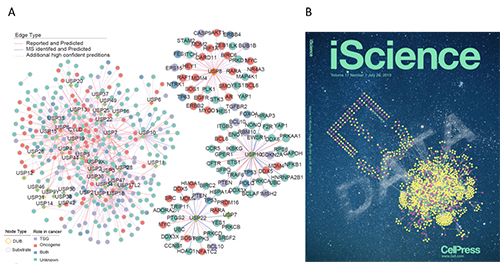Recently, scientists from the Dalian Institute of Chemical Physics (DICP) of the Chinese Academy of Sciences (CAS) defined the key deubiquitination and ubiquitination interaction networks in cancer by bioinformatics methods. Their findings were published in Oncogene and iScience respectively.

A. Schematic diagram of "deubiquitination enzyme - substrate" interaction network predicted by a bioinformatics-based method; B. The study of the "E3 ubiquitin ligase - substrate" interaction was selected as the cover of the iScience journal. (Image by CHEM Di)
The deubiquitination and ubiquitination function is one of the most important post-transcriptional modification processes, it involves in nearly all types of biological processes such as cell cycle, immune process and signal transduction in cells. Meanwhile, dysregulation in the deubiquitination and ubiquitination function may lead to serious diseases, like cancer.
Within the deubiquitination and ubiquitination system, the specific substrate recognition is respectively controlled by the deubiquitination enzyme (DUB) and E3 ubiquitin ligase (E3). However, the relations between the DUB/E3 and substrates are complex, only a small part of substrates are revealed for certain DUBs and E3s and many DUB-substrate and E3-substrate interactions remain unclear, limiting our understanding about the roles of DUBs and E3s.
The scientists utilized the biological big data resources covering molecular structure information, proteomics profiling and biology network to construct the DUB-substrate and E3-substrate interaction prediction models.
Novel substrates for DUBs and E3s were respectively predicted by the models, and further validated by experimental assays. Meanwhile, based on the predicted DUB-substrate interactions, pancancer multi-omics data were also applied to reveal cancer-type-specific DUB-substrate interactions.
These results provide valuable references for studies of deubiquitination and ubiquitination system, and promote the discovery of novel deubiquitination and ubiquitination relevant cancer therapeutic targets.
The above research was supported by the National Natural Science Foundation of China, China Postdoctoral Science Foundation, Innovation program of science and research from the DICP, and dedicated to the 70th anniversary of Dalian Institute of Chemical Physics, CAS. (Text by CHEN DI)